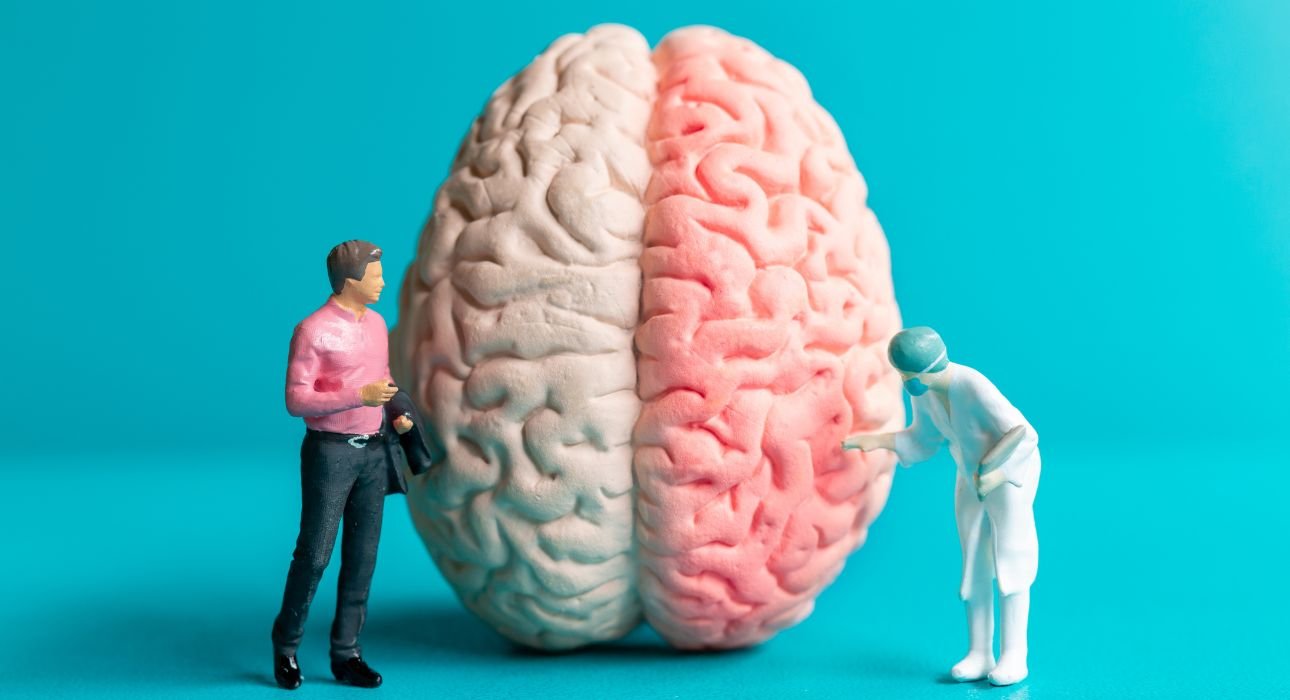Empathy is defined as the ability to take on another person’s thoughts and perspectives, to understand, feel and share and respond to their experience. It is often confused with sympathy, which entails the feeling of being sorry for someone’s grief or misfortune, other than understanding his/her feelings. The brain’s role in processing information about other people’s feelings plays an important role in the generation of empathetic action/behaviour by the person. Thus, despite social and environmental factors, biological factors also have a role to play in the empathetic behaviour of a person. Steps of information processing resulting in empathetic affect/behaviour of a person include:
Perception and Awareness of Social Cues
Empathy begins with perceptual awareness of another person’s emotional state through facial expression, tone of voice, posture, or other social cues. The visual and auditory cortices first process the input, then relay it to brain regions that specialise in social cognition. fMRI research by Carr et al. (2003) shows that viewing emotional facial expressions activates the fusiform face area and superior temporal sulcus, both of which decode social information. These early processes provide the foundation for determining another person’s internal state—a necessary step towards any empathic reaction.
Emotional Resonance via Mirror Neurons
Once the emotion is perceived, the brain initiates an emotional simulation, predominantly facilitated by the mirror neuron system (MNS). Mirror neurons, originally discovered in macaques (Rizzolatti et al., 1996), are activated both when a subject performs an action and when the subject observes another person performing the same action. In human subjects, this is generalised to feelings of emotions. For example, Iacoboni et al. (2005) found that when humans observe others feeling emotions, neurons in the inferior frontal gyrus and inferior parietal lobule are activated in a pattern that simulates the identical affective state in the observer. This embodied, automatic simulation underlies affective empathy, the subjective feeling of another’s emotions.
Interoceptive Awareness and the Insula’s Role
One of the most important regions engaged in mapping body states to feeling states is the anterior insula. This region brings together information about the body’s internal state—e.g., heart rate, gut feeling, and breathing response—with external emotion information, and this creates a gut component of empathy. Craig (2009) emphasised the role of the insula in interoception, the ability to sense the internal state of the body’s physiology, which is the basis of the ability to emotionally empathise with others. In seeing others suffering pain, Singer et al. (2004) reported activation in the anterior insula, with the implication that empathy for pain involves partially “sensing” the other’s pain as if it were happening to oneself.
Cognitive Appraisal and Perspective-Taking
Other than automatic affective resonance, empathy also has a cognitive component—the ability to see the other person’s perspective, or cognitive empathy or theory of mind (ToM). This is way too deliberate processing by including areas such as the medial prefrontal cortex (mPFC) and temporoparietal junction (TPJ). Decety and Jackson (2004) propose that these are the areas where individuals distinguish between their own and other people’s emotional lives, a process that is needed to prevent emotional overload as well as develop appropriate empathic responses, such as comforting or helping.
Integration of Affective and Cognitive Empathy
The full experience of empathy is the product of combining both affective resonance (via mirror neurons and insula) and cognitive perspective-taking (via prefrontal regions). The two processes converge in the anterior cingulate cortex (ACC) and insula, which are also emotional processing and decision-making centres. Functional connectivity between these brain regions determines if and how a person not only shares in feeling with another but also responds to them prosocially. A research by Lamm, Batson, and Deceyt (2007) found that when participants were instructed to empathise or stay neutral, differential insula and ACC activation predicted a higher likelihood of displaying helping behaviour.
Regulation and Contextual Modulation
Empathic processes are also contextually regulated and modulated by emotion regulation strategies. For instance, the prefrontal cortex helps to downregulate excessive levels of emotional arousal when necessary, especially in medical or emergency contexts where excessive levels of affective empathy will be detrimental. Neuroimaging studies by Ochsner et al. (2004) illustrate how reappraisal strategies suppress amygdala and insula activity, consistent with top-down regulation of affective simulation. So, empathy isn’t just automatic—it’s context-dependent, influenced by cultural conventions, situational appropriateness, and end goals.
Empathy-Driven Behavior
From Feeling to Acting. Finally, the overlap among these neural processes results in empathetic behaviour, supporting, showing concern or engaging in prosocial behaviour. This behavioural mode is supported by the ventromedial prefrontal cortex (vmPFC), which integrates affective information with moral reasoning and value-based decision-making. In a study by Masten et al. (2011), vmPFC functioning predicted whether participants would choose to help others at a cost to themselves. Movement from affective empathy to behaviour depends on a motivation system that integrates emotional resonance (via insula and mirror neurons) with moral and social consideration. Also, the neurotransmitters that play active roles in the formation of empathetic affect include:
Oxytocin: The “Empathy Hormone”
Oxytocin, often called the ‘love hormone,’ plays a key role in social attachment and emotional bonding. Across cultures, researchers have linked it to empathic responses. It helps build trust, enhances the recognition of emotional facial expressions, and improves the ability to infer others’ emotions. In a seminal study, Domes et al. (2007) identified that intranasal oxytocin enhanced performance on the “Reading the Mind in the Eyes” test, a commonly used cognitive empathy measure. Furthermore, Hurlemann et al. (2010) showed that oxytocin enhances amygdala and insula response on presentation of emotionally arousing social stimuli, further establishing its contribution to emotional salience.
Dopamine: Motivation and Reward in Prosocial Acts
Dopamine, the primary neurotransmitter of the nucleus accumbens within the brain reward system, operates on empathy by heightening empathic motivation to act. Empathic action, especially if it results in helping or alleviation from the other person’s suffering, engages the mesolimbic reward system—the ventral striatum and nucleus accumbens, which are areas that fall under stringent control of dopamine. Moll et al. (2006) likewise identified that charitable donors exhibited increased activity in such reward areas rich in dopamine, thus confirming that prosocial actions are self-rewarding. Dopaminergic reinforcement highlights how repeated empathic reactions evolve to automatic reactions over the long term.
Serotonin: Empathic Motives and Regulating Aggression
Serotonin influences mood, impulsivity, and social behaviour—all of which impact empathy. Low serotonin levels often lead to increased aggression and reduced empathy, particularly in individuals with antisocial traits.In the study of Crockett et al. (2010), serotonin-augmenting drugs such as SSRs boosted participants’ likelihood of making harm-avoidant choices in moral dilemmas, an indicator of increased empathic concern. By facilitating the inhibition of action and suppression of aggressive drives, serotonin allows for a more controlled, affect-modulated type of empathy, especially in socially complicated contexts.
Read More: 9 Foods that Boost Serotonin
Endorphins and Emotional Resonance
Our brain-endogenous opioids, the endorphins, are associated with relief from pain and emotional bonding and have a function in empathic affect by controlling mutual experience of pain and pleasure. Rütgen et al. (2015) used placebo analgesia for reducing others’ pain and found reduced brain activity of empathy-related brain areas (insula, ACC) when other people were in pain. These were reversed by opioid antagonist administration (naltrexone), showing that endorphin systems are directly involved in empathic pain sharing. Thus, our ability to feel (or inhibit) pain can regulate the intensity of emotional empathy we feel for others.
Glutamate and GABA: Excitation-Inhibition Balance in Empathy Networks
Finally, glutamate and GABA, the two excitatory and inhibitory neurotransmitters of primary significance, establish the balance in the brain for effective empathic emotional and cognitive processing. Dysfunction in this balance has been related to psychiatric disorders such as autism spectrum disorder (ASD) and schizophrenia, in which empathic processing is impaired. Zikopoulos and Barbas (2013) argued that abnormal GABAergic transmission can disrupt prefrontal-insular connections, both affecting affect regulation as well as social knowledge. The findings underscore that even the neurochemical process of empathy depends on coordination among inhibition and excitation by brain networks.
Conclusion
In summary, the development of empathetic affect and behaviour is the outcome of both complex neural processing mechanisms and well-balanced neurochemical regulation. Affective resonance consists of our mirror neuron system and insula, which is the central mechanism for simulating and sharing others’ internal emotional states, and the higher-order regions, such as the prefrontal cortex and temporoparietal junction, facilitating cognitive perspective-taking and regulation of behaviour.
Major neurotransmitters also shape this neural structure. Oxytocin promotes emotional attunement and strengthens social bonds. Dopamine reinforces helping behavior by triggering the brain’s reward system. Serotonin regulates emotions and supports harm aversion. Endorphins facilitate shared emotional experiences, such as pain. The balance between glutamate and GABA ensures proper excitation and inhibition within empathy pathways. Together, these systems enable empathy to appear not only as a transient feeling but as a motivated, context-dependent behaviour grounded both in the body and brain. Greater insight into how these mechanisms work has far-reaching potential for increasing empathy in clinical, educational, and interpersonal settings.
FAQs
1. Why is empathy considered to be the most important quality?
Empathy is considered important because it helps an individual build a sense of self. It also allows them to connect more deeply with others who may need help. This, in turn, enables healthier relationship formation and improves social interaction.
2. What can be done to enhance Empathy?
To enhance empathy, one can practice active listening, show unconditional positive regard, and foster mutual respect and commitment. These practices are increasingly being applied effectively in various interpersonal and professional settings. Also, making the other person feel a sense of belongingness also helps.
3. Do Social factors contribute to Empathy formation?
Yes, Social factors do play a significant role in empathy formation. Socialisation is the process that allows an individual to understand what is actually going around in the social sphere, allowing individuals to connect with people, thus enhancing the connections and feelings of mutual belongingness.
References +
References +
- Carr, L., Iacoboni, M., Dubeau, M. C., Mazziotta, J. C., & Lenzi, G. L. (2003). Neural mechanisms of empathy in humans: A relay from neural systems for imitation to limbic areas. Proceedings of the National Academy of Sciences, 100(9), 5497–5502. https://doi.org/10.1073/pnas.0935845100
- Craig, A. D. (2009). How do you feel—now? The anterior insula and human awareness. Nature Reviews Neuroscience, 10(1), 59–70. https://doi.org/10.1038/nrn2555
- Crockett, M. J., Clark, L., Hauser, M. D., & Robbins, T. W. (2010). Serotonin selectively influences moral judgment and behavior through effects on harm aversion. Proceedings of the National Academy of Sciences, 107(40), 17433–17438. https://doi.org/10.1073/pnas.1009396107
- Decety, J., & Jackson, P. L. (2004). The functional architecture of human empathy. Behavioral and Cognitive Neuroscience Reviews, 3(2), 71–100. https://doi.org/10.1177/1534582304267187
- Domes, G., Heinrichs, M., Michel, A., Berger, C., & Herpertz, S. C. (2007). Oxytocin improves “mind-reading” in humans. Biological Psychiatry, 61(6), 731–733. https://doi.org/10.1016/j.biopsych.2006.07.015
- Hurlemann, R., Patin, A., Onur, O. A., Cohen, M. X., Baumgartner, T., Metzler, S., … & Kendrick, K. M. (2010). Oxytocin enhances amygdala-dependent, socially reinforced learning and emotional empathy in humans. Journal of Neuroscience, 30(14), 4999–5007. https://doi.org/10.1523/JNEUROSCI.5538-09.2010
- Iacoboni, M., Molnar-Szakacs, I., Gallese, V., Buccino, G., Mazziotta, J. C., & Rizzolatti, G. (2005). Grasping the intentions of others with one’s own mirror neuron system. PLoS Biology, 3(3), e79. https://doi.org/10.1371/journal.pbio.0030079
- Lamm, C., Batson, C. D., & Decety, J. (2007). The neural substrate of human empathy: Effects of perspective-taking and cognitive appraisal. Journal of Cognitive Neuroscience, 19(1), 42–58. https://doi.org/10.1162/jocn.2007.19.1.42
- Masten, C. L., Morelli, S. A., & Eisenberger, N. I. (2011). An fMRI investigation of empathy for ‘social pain’ and subsequent prosocial behavior. NeuroImage, 55(1), 381–388. https://doi.org/10.1016/j.neuroimage.2010.11.060
- Moll, J., Krueger, F., Zahn, R., Pardini, M., de Oliveira-Souza, R., & Grafman, J. (2006). Human fronto–mesolimbic networks guide decisions about charitable donation. Proceedings of the National Academy of Sciences, 103(42), 15623–15628. https://doi.org/10.1073/pnas.0604475103
- Ochsner, K. N., Bunge, S. A., Gross, J. J., & Gabrieli, J. D. (2002). Rethinking feelings: An fMRI study of the cognitive regulation of emotion. Journal of Cognitive Neuroscience, 14(8), 1215–1229. https://doi.org/10.1162/089892902760807212
- Rizzolatti, G., Fadiga, L., Gallese, V., & Fogassi, L. (1996). Premotor cortex and the recognition of motor actions. Cognitive Brain Research, 3(2), 131–141. https://doi.org/10.1016/0926-6410(95)00038-0
- Rütgen, M., Seidel, E. M., Riečanský, I., & Lamm, C. (2015). Reduction of empathy for pain by placebo analgesia suggests functional equivalence of empathy and first-hand emotion experience. Journal of Neuroscience, 35(23), 8938–8947. https://doi.org/10.1523/JNEUROSCI.3936-14.2015
- Singer, T., Seymour, B., O’Doherty, J., Kaube, H., Dolan, R. J., & Frith, C. D. (2004). Empathy for pain involves the affective but not sensory components of pain. Science, 303(5661), 1157–1162. https://doi.org/10.1126/science.1093535
- Zikopoulos, B., & Barbas, H. (2013). Altered neural connectivity in excitatory and inhibitory cortical circuits in autism. Frontiers in Human Neuroscience, 7, 609. https://doi.org/10.3389/fnhum.2013.00609













Leave feedback about this